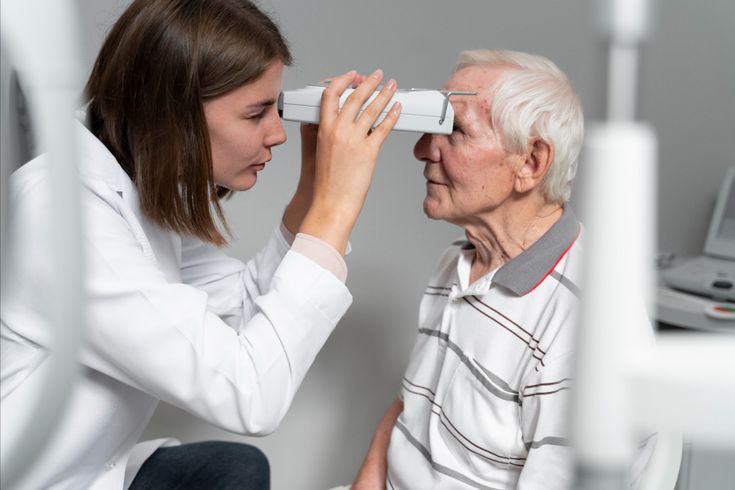Can Nearsightedness “Go Away” with Age?

“Slow reaction” to screens can be an early sign of presbyopia or progressive myopia
Many people believe that as they get older, their eyes will become farsighted due to aging, balancing out their nearsightedness and eventually eliminating it. However, according to ophthalmologists, this is entirely incorrect. The eyes cannot naturally recover from myopia with age—myopia and presbyopia are two completely different conditions that can coexist and severely affect vision.
Why Can’t Nearsightedness Disappear with Age?
Myopia occurs when light focuses in front of the retina, causing distant objects to appear blurry. This often happens because the eyeball is elongated or the cornea is too curved. Once the eye’s structure changes in this way, it cannot revert to its original shape naturally.
Presbyopia, on the other hand, is a natural age-related process that typically begins after age 40. It occurs when the eye’s lens and ciliary muscles lose elasticity, making it difficult to focus on nearby objects. For those who already have myopia, the overlap of these two conditions can sometimes make near vision seem clearer, but it does not mean the nearsightedness has disappeared.
Experts confirm:
“Myopia and presbyopia do not cancel each other out. Older adults still need appropriate corrective glasses, often bifocals, to see clearly at both distance and near.”
If left untreated or unmanaged, progressive nearsightedness in older adults can lead to serious complications such as retinal degeneration, early cataracts, or glaucoma.
Why Does Myopia Persist into Old Age?

Regular eye exams every 3–6 months help detect complications of myopia early in older adults
Myopia is not just a childhood condition—it can continue and progress quietly through adulthood due to multiple factors:
- Genetics: Children of nearsighted parents are more likely to inherit myopia, especially if they carry the APLP2 gene associated with elongated eyeballs.
- Habits and lifestyle: Prolonged reading, computer use, or focusing on close objects forces the eyes to constantly accommodate, which can lengthen the eyeball over time.
- Environmental factors: Poor lighting, air pollution, and limited outdoor activity can all contribute to myopia progression.
- Diet: Excess sugar, high-calorie foods, and a lack of vitamins A, E, and omega-3 fatty acids can impair visual health.
- Physical inactivity: Lack of exercise reduces blood and oxygen flow to the eyes, weakening eye muscles and accommodation ability.
In middle-aged and elderly individuals, these factors, combined with natural aging, make treating myopia more complex and increase the risk of developing other eye diseases.
Serious Complications of Untreated Myopia in Old Age
Without proper management by the ages of 40–50, the risk of retinal and other ocular disorders rises significantly. Below are some of the most common complications:
1. Diabetic Retinal Detachment
Severe myopia stretches the retina and elongates the eyeball, while diabetes weakens and ruptures the eye’s blood vessels, leading to retinal detachment. According to the U.S. National Eye Institute, 4 in 10 patients with diabetic retinal detachment face a risk of permanent blindness.
2. Cataracts
About 50% of individuals over 65 show signs of cataract formation, and this rate is even higher in those with high myopia over -6 diopters. The lens becomes cloudy, blurring vision and potentially leading to blindness if untreated surgically.
3. Glaucoma
High myopia is a major risk factor for glaucoma. The disease damages the optic nerve, progressively narrows the visual field, and can cause irreversible vision loss if not diagnosed early.
4. Macular Degeneration
In elderly patients with myopia, retinal stretching can damage the central retina (macula), leading to distortion or blurred vision. Macular degeneration remains one of the leading causes of blindness in people over 60.
5. Combined Complications
Older individuals with myopia often have coexisting conditions such as hypertension, diabetes, or cardiovascular disease, all of which can accelerate vision decline. Therefore, regular eye checkups every six months are crucial.
How to Maintain Healthy Eyesight with Myopia in Old Age

Good vision is the key to an active and confident life.
To protect your vision and minimize the risk of complications related to myopia in later life, follow these key habits:
- Eat foods rich in vitamins A, C, E, lutein, and omega-3—such as carrots, salmon, kale, and pumpkin—to nourish the retina and prevent degeneration.
- Exercise regularly. Just 30 minutes of walking, yoga, or swimming each day improves blood circulation and oxygen flow to the eyes.
- Massage gently around the eyes for 10–15 minutes daily to relax muscles and relieve dryness or strain.
- Limit screen time and enable night-time eye protection mode on devices.
- Have comprehensive eye exams every 3–6 months to detect early signs of cataracts or glaucoma.
Solutions for Older Adults Who Want to Improve Their Vision
Today, Phakic ICL (Phakic ICL) surgery is considered one of the safest and most effective solutions for patients with high myopia or thin corneas who are not suitable for LASIK. According to STAAR Surgical, the Phakic ICL lens is made from Collamer—a biocompatible material that naturally integrates with the eye, does not cause dry eye, can be removed if necessary, and allows recovery within 1–2 days.
The Phakic ICL provides sharp vision both day and night, reduces corneal risks, and is ideal for individuals aged 21–45 with myopia up to -20 diopters. This approach also gives middle-aged or older adults the opportunity to regain clear vision without altering the eye’s natural structure.
Myopia cannot disappear naturally with age—in fact, it carries increasing risks if left unmanaged. Taking proactive care of your eyes through regular checkups and choosing the right treatment options is the key to maintaining healthy vision and enjoying a fulfilling life in your later years.

 vi
vi 06-Nov-2025
06-Nov-2025










 0916.741.763
0916.741.763 Appointment
Appointment